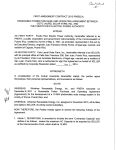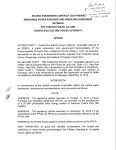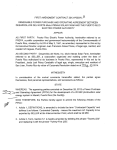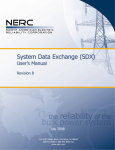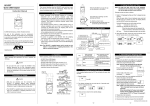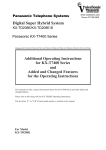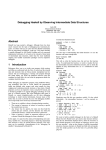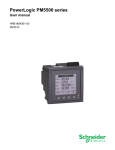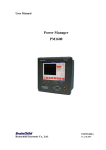Download -fy J>\Soo,o£>e> - oo SECOND AMENDMENT CONTRACT
Transcript
-fy J>\Soo,o£>e> - o o
L
SECOND AMENDMENT CONTRACT 2 0 1 2 - P 0 0 0 4 5 ^
° ' "
RENEWABLE POWER PURCHASE AND OPERATING AGREEMENT BETWEEN
RENEWABLE ENERGY AUTHORITY, LLC AND
THE PUERTO RICO ELECTRIC POWER AUTHORITY
3
l
APPEAR
AS FIRST PARTY: Puerto Rico Electric Power Authority, hereinafter referred to as
PREPA, a public corporation and government instrumentality of the Commonwealth of
Puerto Rico, created by Act 83 of May 2, 1941, as amended, represented in this act by
its Executive Director, engineer Juan Francisco Alicea Flores, of legal age, married, and
resident of Caguas, Puerto Rico.
AS SECOND PARTY: Renewable Energy Authority, LLC, hereinafter referred to as
SELLER, a corporation organized and existing under the laws of Delaware authorized to
do business in Puerto Rico, represented in this act by its President, Ruben Gonzalez
Cruz, of legal age, and resident of Bayamon, by virtue of Corporate Resolution dated as
of May 19, 2014.
WITNESSETH
In consideration of the mutual covenants hereinafter stated, the Parties agree
themselves, their personal representatives, and successors as follows:
STATE
WHEREAS: SELLER and PREPA executed on November 2 1 , 2011 a Renewable
Power Purchase and Operating Agreement ("Agreement"), as amended by Amendment
No. 1 dated as of May 17, 2012 ("Amendment No. 1"), collectively hereinafter referred to
as the "Agreement", for the development of a 20 MW photovoltaic solar energy system
in Vega Baja, Puerto Rico ("Facility"); and
NOW THEREFORE, the Parties hereby agree to amend the following Articles of the
Agreement:
1. Article 1, DEFINITIONS, is amended to include the term "Contracted Capacity" and
defines it as follows: means the maximum AC Capacity to be delivered by SELLER
at the Interconnection Point, which shall be 20 MW.
2. Article 1, DEFINITIONS, the Term Emergency is amended as follows: Emergency means an operational condition or situation affecting PREPA's system (including
security and reliability), that in the reasonable judgment of PREPA, based on the
,
' " '
i
S
Second Amendment Contract 2012-P00045 - Renewable Energy Authority, LLC
Page 2
Prudent Utility Practices and the Prudent Electrical Practices applicable, is likely to
result in imminent disruption of service to a significant number of its customers, or is
imminently likely to endanger life, or cause damage to property.
3. Article 5, Term, Section 5.1 is hereby amended by deleting the word "Twenty (20)"
and replacing it with the word "Twenty-Five (25)".
4. Article 5, Term, Section 5.2 is hereby amended by deleting the first sentence "The
Term of this Agreement may be extended by mutual agreement of the Parties for up
to two consecutive periods of five (5) years each, following the expiration of the initial
Twenty Agreement Year Term." and replacing it with the sentence "The Term of this
Agreement may be extended by mutual agreement of the Parties for one
consecutive period of five (5) years, following the expiration of the initial Twenty-Five
Agreement Year Term."
5. Articles 7, Dispatching and 8, Control and Operation of The Facility are hereby
amended by deleting in its entirety and replacing it with the following language:
ARTICLE 7. DISPATCHING
7.1
PREPA agrees that the Facility will be designated as a "must run" unit
the full extent of the Contracted Capacity of 20 MW) and will not
disconnected except to the extent necessary due to a Force Majeure or
Emergency that cannot be avoided or mitigated without the shutdown
disconnection of the Facility.
(to
be
an
or
7.2
Notwithstanding Section 7.1, PREPA may require SELLER to disconnect
the Facility or reduce the amount of Net Electrical Output by curtailment
due to operating conditions that may affect safety margins or reliability
levels in PREPA's electrical system; provided, however, any reduction in
the level of Net Electrical Output or disconnection required by PREPA
hereunder shall be based upon and implemented in a manner consistent
with Prudent Utility Practices. PREPA shall not be entitled to disconnect
the Facility or reduce Net Electrical Output under this Agreement due to
(a) economic factors, (b) any inconvenience or other condition not
expressly included in the preceding sentence, (c) any condition of any
nature including those specified in the preceding sentence if PREPA is not
Second Amendment Contract 2012-P00045 - Renewable Energy Authority, LLC
Page 3
promptly and prudently seeking a remedy to cure in accordance with
Prudent Electrical Practices, and (d) any other circumstance that can be
mitigated by PREPA through economic means. Some of these situations
may include but are not limited to; power quality problems in
Vega Baja TC, as well as outages and disconnections ("vias libres") of the
above mentioned transmission center due to disturbances, maintenance
and/or improvement.
7.3
Notwithstanding Sections 7.1 and 7.2 above PREPA may also disconnect
the Facility or reduce the Net Electrical Output by curtailment when the
following conditions are present: (a) the Facility fails to comply with the
requirements of APPENDIX E, MINIMUM TECHNICAL REQUIREMENTS
FOR INTERCONNECTION OF PHOTOVOLTAIC (PV) FACILITIES, which
include but are not limited to: power factor, low/high voltage ride through,
low/high frequency ride through, voltage control requirements, power
quality requirements and frequency response, as set forth in
APPENDIX E, or if PREPA has amended the requirements of
APPENDIX E, then only if such amendment is applicable to the Facility
pursuant to Section 9.13 and (x) the SELLER has received written notice
of any such amendment; (y) SELLER has had an appropriate period of
time to comply with any such amended requirement and (z) PREPA has
agreed to reimburse SELLER for any costs in excess of the Modification
Limit pursuant to Section 9.13; (b) SELLER fails to perform annual tests
for compliance with the MINIMUM TECHNICAL REQUIREMENTS FOR
INTERCONNECTION OF PHOTOVOLTAIC (PV) FACILITIES as required
in Section 12.2, and (c) SELLER fails to keep the Facility PSS/E
mathematical models current with the future versions of the PSS/E
program thirty (30) Days after a PSS/E version upgrade is notified in
writing by PREPA to SELLER, provided that PREPA's notice shall include
all the necessary technical information needed by SELLER and the
manufacturer to update the model, and provided further that the upgrade
of the model is feasible in that 30 Day time period. If for any reason,
information from the manufacturer is required, as such information is
proprietary and confidential; SELLER shall obtain the manufacturer's
approval or performed the necessary change to provide a functional
upgraded PSS/E mathematical model. For the avoidance of doubt, any
disconnection due to (a) and (b) above may be of an extended or
Second Amendment Contract 2012-P00045 - Renewable Energy Authority, LLC
Page 4
permanent nature if not cured by SELLER in a timely manner; and PREPA
shall have no liability to SELLER in connection with those disconnections
as per Sections 7.1, 7.2 and 7.3. Any disconnection shall end promptly
after SELLER cures such non-compliance.
7.4
Following the Commercial Operation Date, SELLER will provide to PREPA
a non-binding estimate of short term, next Day and next week production,
based on the previous Day production, estimated strength of the solar
radiation the next Day and week and based on the meteorological forecast
for the region and site. The Parties shall include in the Agreed Operating
Procedures the procedures and protocols necessary for providing said
estimates.
7.5
PREPA acknowledges no intent to reduce the Net Electrical Output by
curtailment or disconnection under this Agreement outside of those
described in this Article 7 and Article 8.
ARTICLE 8. CONTROL AND OPERATION OF THE FACILITY
8.1
SELLER shall, at least sixty (60) Days prior to the Commercial Operation
Date, submit a written schedule of Scheduled Outages ("Scheduled
Outage Program") for the remaining portion of the first Year of the
Facility's operations and, if the Commercial Operation Date occurs after
September 1, for the following Year, setting forth the proposed Scheduled
Outage periods. Thereafter, SELLER shall submit to PREPA, in writing,
by September 1 of each Year, its proposed Scheduled Outage Program
for the next Year.
8.2
SELLER shall use reasonable efforts to notify PREPA of any
Non-Scheduled Outages at least twenty four (24) hours in advance and
coordinate all Non-Scheduled Outages with PREPA.
8.3
If an Emergency is declared by PREPA, PREPA's dispatching centers
may disconnect the Facility from PREPA's system, or reduce the Net
Electrical Output by curtailment, to the extent permitted by Article 7.2. If
an Emergency or operating condition pursuant to Article 7.2 is declared by
PREPA, PREPA's dispatching centers may curtail the Facility's output.
The Facility will remain curtailed or disconnected from PREPA's system
Second Amendment Contract 2012-P00045 - Renewable Energy Authority, LLC
Page 5
following an Emergency until SELLER has received permission to
reconnect from PREPA's dispatching center.
Any disconnection or
reduction in the Facility's output required by PREPA under this Agreement
shall be of no greater scope and of no longer duration than is required by
the Emergency or operating condition pursuant to Article 7.2, consistent
with Prudent Utility Practices. Upon an Emergency or operating condition
pursuant to Article 7.2 that results in any disconnection or reduction in the
Facility's output, PREPA shall, as soon as practicable after the occurrence
of the Emergency or operating condition, provide written notice to SELLER
describing the particulars of the occurrence and its estimated duration and
shall diligently use all reasonable efforts, consistent with Prudent Utility
Practices, to remedy the Emergency or operating condition. In any
situation were PREPA causes a reduction of Net Electrical Output or a
disconnection of the Facility, PREPA shall treat the Facility no less
favorably than other facilities connected to PREPA's grid on such
occurrences.
8.4
PREPA shall have no liability to SELLER in connection with any
disconnection or reduction in the Facility's output required by PREPA
under Section 7.1, Section 7.2 or Section 8.3 unless (a) the Facility is
otherwise capable of generating and delivering electrical output, (b) Seller
has provided PREPA with written notice of such capability, and (c) the
duration of any such disconnection or curtailment (or combination thereof)
has exceeded the applicable waiting period set forth in the next three
sentences after delivery of SELLER'S notice to PREPA. With respect to a
disconnection or curtailment that is not attributable to severe weather
conditions, the waiting period shall be the earliest to occur of (i) a
maximum twenty four (24) consecutive hours, (ii) twenty four (24) hours in
the aggregate during any thirty (30) Day period and (iii) one hundred
twenty (120) hours in the aggregate during any Year. With respect to a
disconnection or curtailment that is attributable to severe weather
conditions, including a hurricane or tropical storm, the waiting period shall
be the earlier to occur of (i) seven (7) consecutive Days and (ii) three
hundred (300) hours in the aggregate during any Year. To the extent a
disconnection or curtailment (or combination thereof) exceeds any of the
time periods described in the preceding sentences (as applicable), then
PREPA shall pay as determined in Section 11.2(a) to SELLER for each
Second Amendment Contract 2012-P00045 - Renewable Energy Authority, LLC
Page 6
hour of the curtailed energy after the waiting period in accordance with
APPENDIX F, DETERMINATION OF NET ELECTRICAL OUTPUT NOT
RECEIVED. PREPA's liability pursuant to this Section 8.4 for any single
disconnection or curtailment shall be offset by any insurance proceeds
actually received by Seller from any business interruption insurance policy
that Seller may obtain.
8.5
Each Party shall cooperate with the other in establishing Emergency
plans, including recovery from a local or widespread electrical blackout;
voltage reduction in order to effect load curtailment; and other plans which
arise. SELLER shall make technical information and data available to
PREPA concerning start-up times and black-start capabilities.
8.6
If the Facility has a Scheduled Outage or a Non-Scheduled Outage, and
such Scheduled Outage or Non-Scheduled Outage occurs or would occur
coincident with an Emergency, PREPA may request that SELLER shall
make reasonable efforts, consistent with Prudent Utility Practices and with
PREPA's approval, to reschedule the Scheduled
Outage
or
Non-Scheduled Outage or if the Scheduled Outage or Non-Scheduled
Outage has begun, to expedite the completion thereof.
8.7
SELLER shall provide as a minimum at its expense, and PREPA shall
install, were applicable, as SELLER expense, the following communication
facilities linking the Facility with PREPA's dispatching centers:
(a) One Remote Terminal Unit ("RTU"), including setup installation and
configuration; which shall be specified by PREPA.
(b) Two independent telecommunication circuits. One voice grade to link
the SCADA system to the facility RTU using DNP protocol though a
designated PREPA communication node. A second fiber optic circuit
to link PREPA's network to the facility in order to access protection
equipment, revenue meters and the DSM, trough the ruggedcom
security device as specified by PREPA.
(c) A voice telephone extension for the purpose of communicating with
Monacillos TC and Ponce TC.
Second Amendment Contract 2012-P00045 - Renewable Energy Authority, LLC
Page 7
(d) A telephone line and equipment to transmit and receive facsimile
messages to confirm the oral communication between PREPA and
SELLER.
(e) A Dynamic System Monitor equipment in accordance with
APPENDIX E - TECHNICAL SPECIFICATIONS FOR THE DYNAMIC
SYSTEM MONITOR, for recording the power disturbance caused by
electro-mechanic swings and to measure the system response to the
swing disturbance.
SELLER shall be responsible of providing,
installing, wiring and commissioning of all the equipment and
components for the DSM system necessary in the Interconnection
Facilities.
The items provided by SELLER in accordance with this Section 8.7 shall
be subject to the approval of PREPA, within thirty (30) calendar days of
SELLER providing the required specifications.
8.8
Each Party shall keep complete and accurate records and other data
required for the proper administration of this Agreement.
(a) All such records shall be maintained for a minimum of five (5) years
after the preparation of such records or data and for any additional
length of time required by regulatory agencies with jurisdiction over
the Parties; provided, however, that neither Party shall dispose of or
destroy any records without thirty (30) Days prior notice to the other
Party. Within ten (10) Days after receipt of the notice of intention to
destroy or dispose, the other Party shall have the right to require the
notifying Party in writing to retain and deliver to it certain records at its
sole cost and expense. Any records so notified shall be delivered to
the Party requesting their return in no more than ten (10) Days except
for any information that is deem confidential information by the
disclosing Party or that it may not otherwise be delivered because is
protected by intellectual property rights. The disclosing Party shall
deliver a list of all the documents or items, not being delivered
because they are confidential or subject to proprietary rights, but not
the actual documents or items.
(b) SELLER shall maintain an accurate and up-to-date operating log at
the Facility with records of (i) real and reactive power for each hour,
(ii) changes in operating status and Scheduled Outages, and (iii) any
unusual conditions found during inspections.
Second Amendment Contract 2012-P00045 - Renewable Energy Authority, LLC
Page 8
.(c) Either Party shall have the right from time to time, upon fourteen (14)
Days written notice to the other Party and during regular business
hours, to examine the records and data of the other Party relating to
the proper administration of this Agreement any time during the period
the records are required to be maintained.
8.9
At PREPA's request, SELLER shall provide certifications of tests and
inspections of the electric and protection equipment, which may impact
PREPA's electrical system. PREPA shall have the right to visit and
visually monitor the Facility during operation and testing, including any
acceptance testing of the Facility.
6. Article 11, Compensation , Payment and Billing, Section 11.2 in the PPOA is hereby
amended by deleting that Section in its entirety and replacing it with the following:
11.2
(a)
Energy Payment - Beginning with the Pre-Operation Period and
continuing throughout the Term of this Agreement:
EP = E P P x N E O
Where:
EP is the Energy Payment.
EPP is the Energy Purchase Price, which for the first Agreement Year
shall be equal to $0.1450/kWh of NEO.
NEO is the Net Electrical Output expressed in kilowatt hours.
Commencing on the first anniversary of the Commercial Operations
Date (commencement of Agreement Year 2), and each year thereafter
up to and including the Agreement Year 20, the Energy Purchase Price
shall be escalated in an amount equal to two percent (2.0%) annually.
For Agreement Years 21 to 25 the Energy Purchase Price shall be
$0.1450/kWh of NEO, not subject to escalation.
The calculation of the Energy Payment is included in Appendix C.
11.2
(b)
Green Credits Payment - Beginning with the Pre-Operation Period and
continuing throughout the Term of this Agreement:
Second Amendment Contract 2012-P00045 - Renewable Energy Authority, LLC
Page 9
GCP = G C P P x N E O
Where:
GCP is the Green Credits Payment
GCPP is the Green Credit Purchase Price for Agreement
Years 1 to 25, which shall be equal to $0.0225/kWh of NEO
and not subject to escalation.
The calculation of the Green Credit Purchase Price is included
in Appendix C.
7. Article 16, TERMINATION, in the Agreement is hereby amended by deleting
in its entirety and replacing it with the following:
r
Termination of this Agreement shall occur only upon: (a) expiration of the
Term of this Agreement as provided in Article 5; (b) mutual written consent of
the Parties; (c) the election of PREPA following a Development Abandonment
or Permanent Closing; (d) the election of the non-defaulting Party following
the occurrence of a Breach under Article 17; (e) the election of PREPA
following delay by SELLER in achieving Commencement of Construction by
six (6) months after the Effective Date of this Second Amendment; (f) delay
by SELLER in achieving the Commercial Operation Date by the date which is
eighteen (18) Months after the Effective Date of this Second Amendment; or
(g) the circumstances provided in Section 16.2.
Notwithstanding the
foregoing, the terms under subsections (e) and (f) of this paragraph shall be
extended, if such delay is caused by a Force Majeure event, Pending
Permits, Legal Challenge or an act or omission by PREPA.
8. Substitution of Appendix B - INTERCONNECTION is hereby substituted and
replaced in its entirety by APPENDIX B - INTERCONNECTION, attached hereto.
9. Substitution of Appendix C - Example of Price Index Calculation is hereby
substituted and replaced in its entirety by APPENDIX C - AMENDED ENERGY AND
GREEN CREDIT PURCHASE PRICE, attached hereto.
Second Amendment Contract 2012-P00045 - Renewable Energy Authority, LLC
Page 10
10.Substitution of APPENDIX D - TECHNICAL SPECIFICATION FOR DYNAMIC
SYSTEM MONITOR, is hereby substituted and replaced in its entirety by
APPENDIX D - TECHNICAL SPECIFICATION FOR DYNAMIC SYSTEM
MONITOR, attached hereto.
11. Substitution of APPENDIX
E - PRELIMINARY
MINIMUM
TECHNICAL
REQUIREMENTS
FOR
INTERCONNECTION
OF
PHOTOVOLTAIC
(PV)
FACILITIES is hereby substituted and replaced in its entirety by APPENDIX E MINIMUM TECHNICAL
REQUIREMENTS
FOR
INTERCONNECTION
OF
PHOTOVOLTAIC (PV) FACILITIES, attached hereto.
12. A new APPENDIX F - DETERMINATION OF NET ELECTRICAL OUTPUT NOT
RECEIVED, attached hereto, is included.
13. The above mentioned amendments apply to all terms and conditions of the
Agreement, as applicable.
14. Representations and Warranties of each Party.
(a) PREPA hereby represents and warrants to SELLER: (i) the execution and
delivery by PREPA of this Amendment, and the Amendment itself, have been
duly authorized by PREPA's Governing Board and any other applicable PREPA
governing body in accordance with applicable law, and (A) do not and will not
require any additional internal or external consent or approval, (B) do not and will
not violate any provision of Act No. 83 of May 2, 1941, as amended, or its
regulations, or any material indenture, contract or agreement to which it is a party
or by which its properties may be bound; and (ii) this Amendment is a legal, valid,
and binding obligation of PREPA, enforceable against PREPA in accordance
with its terms, except as may be limited by applicable bankruptcy, insolvency or
similar laws affecting the enforcement of rights generally.
(b) SELLER hereby represents and warrants to PREPA: (i) the execution, delivery,
and performance by SELLER of this Amendment have been duly authorized, and
do not and will not (A) require any additional internal consent or approval of
SELLER, or (B) violate any provision of SELLER'S certificate of formation or
operating agreement, or any material indenture, contract or agreement to which
it is a party or by which it or its properties may be bound, or any law, ordinance,
Second Amendment Contract 2012-P00045 - Renewable Energy Authority, LLC
Page 11
rule, regulation, order, writ, judgment, injunction, decree, determination or award
presently in effect; and (ii) this Amendment is a legal, valid and binding obligation
of SELLER, enforceable against SELLER in accordance with its terms, except as
may be limited by applicable bankruptcy, insolvency or similar laws affecting the
enforcement of rights generally.
15. Ratification.
Except as expressly amended hereby, the Agreement and all
documents, instruments and agreements related thereto are hereby ratified and
confirmed in all respects.
16. No Implied Waiver. This Amendment shall be limited precisely as written and shall
not be deemed to be a consent granted pursuant to, or a waiver or modification of,
any other term or condition of the Agreement, whether or not known to the Parties,
or to prejudice any other right or rights which the Agreement may now have or have
in the future.
17. Counterparts. This Amendment may be executed in multiple original or facsimile
counterparts, each of which shall be deemed an original and shall be binding upon
the Party who executed the same, but all of such counterparts shall constitute the
same Amendment.
18. Governing Law. This Amendment shall be governed by, construed and enforced in
accordance with the laws of the Commonwealth of Puerto Rico and, to the extent
applicable, the laws of the United States of America. The Parties herein agree that
all Disputes arising hereunder shall be resolved pursuant to Section 21.12 of the
Agreement.
19. Novation: SELLER and PREPA expressly agree that no amendment or change
order which could be made to the Agreement and this Second Amendment, during
its term, shall be understood as a Contractual Novation, unless both Parties agree to
the contrary, specifically and in writing. The previous provision shall be equally
applicable in such other cases where PREPA gives the SELLER a time extension for
the compliance of any of its obligations under the Agreement as amended or where
PREPA dispenses the claim or demand of any of its credits or rights under the
Agreement as amended.
Second Amendment Contract 2012-P00045 - Renewable Energy Authority, LLC
Page 12
20. Capitalized Terms.
Unless otherwise stated, capitalized terms used in this
Amendment which are not defined in this Amendment have the meaning given in the
Agreement.
All other terms and conditions, specifications, stipulations, insurances, and
requirements established in the Agreement remain unaltered and fully enforceable.
This is the Agreement between the appearing parties under this Second Amendment
and so is hereby ratified.
IN WITNESS WHEREOF, the Parties hereto have agreed to execute this Second
Amendment in San Juan, Puerto Rico, on this 2 1 day of May, 2014 ("Effective Date of
this Second Amendment").
s t
Puerto Rico Electric Power Authority
Renewable Energy Authority, LLC
Executive Director
Social Security 660-43-3747
President
Social Security 453-62-8501
APPENDIX B
INTERCONNECTION
Seller shall provide the following information to PREPA within ninety (90) days following
the Effective Date. Data submitted in a preliminary or estimated form shall be updated
within thirty (30) days after final equipment arrangements and specifications are
established.
1.
Electrical one-line diagram of the Facility.
2.
Explanation of proposed equipment protection and control scheme (may be
shown functionally on the one-line diagram).
3.
Site plan showing plant layout, property lines, access roads and switchyard
boundaries.
4.
Preliminary equipment layout and arrangement for switchyard and PV Facility
step-up transformers (GSU).
5.
Reactive Power Capacity curve of PV Facility.
6.
Station auxiliary load.
7.
Station auxiliary transformer data - impedance, connection winding, load loss
and no load tap changer.
8.
PV Facility step-up transformer impedance, load loss, no load taps changer,
connection and winding.
9.
PV Facility Short Circuit Ratio.
10. PV Facility kilowatt rating.
11. PV Facility kilovar rating.
12. Equivalent PV Facility modeling for Short Circuit Studies.
13. Seller's requirements for power supplied by PREPA during construction and
start-up.
14. Project schedule (l-J or bar chart format) including but not limited to the
following milestones:
QF status obtained
Engineering 30% complete
One-line diagram approved
Financial Closing Date
Appendix B - Interconnection
Page 2
Major licenses/permits
Major material procurement
Start Construction
Engineering 70% complete
Utility technical submittals complete
Operating procedures finalized
Field Test Protocols Finalized
Start test and start-up
On-site Field Tests Completed
Complete Compliance with Minimum Technical Requirements
Initial synchronizing date
Commercial operation
15. PSSE Mathematical Model (Parameters and Data Requirements)
The Contractor shall submit to PREPA a PSS/E mathematical model and data
related to the proposed PV Facility. When referred to the PV Facility model,
this shall include but is not limited to PV converter, transformers, collector
systems, plant controllers, control systems and any other equipment necessary
to properly model the PV Facility for both steady-state and dynamic simulation
modules. It is required that the Contractor submits both an aggregate and
detailed model of the PV Facility. The aggregate and detailed model of the PV
Facility shall not be submitted in preliminary form.
The Contractor shall be required to submit user manuals for both the PV
converter and PV Facility models. The mathematical models shall be fully
compatible with the latest and future versions of PSS/E. It is preferred that the
models are PSS/E standard models. In the case that the Contractor submits
user written models, the Contractor shall be required to keep these models, as
well as its corresponding user manual, current with the future versions of the
PSS/E program until such time that PSS/E has implemented a standard model.
On-site field tests to demonstrate compliance with PREPA's Minimum Technical
Requirements for Interconnection of Photovoltaic Facilities (MTRs) shall be
performed by the contractor. The data and PSS/E model shall also be
validated, updated and officially certified according to PREPA requirements
when final field adjustments and parameters measurements are completed
during the on-site field tests to be performed to the facility by the contractor.
The on-site field tests shall be witnessed and coordinated with PREPA's
personnel.
The Contractor shall be responsible to submit PSSE mathematical models of
any kind of compensation devices (ie. SVC, STATCOMs, DSTATCOMs, BESS,
etc.) used on the PV Facility. It is preferred that the models are standard
models provided with PSS/E. In the case that the Contractor submits user
written models, the PV Facility Contractor shall be required to keep these
Appendix B - Interconnection
Page 3
models current with the future versions of the PSS/E program until such time
that PSS/E has implemented a standard model.
In its final form, the
mathematical model shall be able to simulate each of the required control and
operational modes available for the compensation device and shall be
compatible with the latest and future versions of PSSE. Final adjustments and
parameters settings related with the control system commissioning process
shall be incorporated to the PSSE mathematical model and tested accordingly
by the PV Facility Contractor and PREPA system study groups.
PV Facility Owners that provide user written model(s) shall provide compiled
code of the model and are responsible to maintain the user written model
compatible with current and new releases of PSS/E until such time a standard
model is provided. PREPA must be permitted by the PV Facility Owner to
make available PV models if required to external consultants with an NDA in
place.
16. Additional data necessary for dynamic modeling - At a minimum, any necessary
control system model (inverter, compensator and excitation limiter models),
including the time constants, gains, limits, description, block diagrams and
configuration.
17. Transient Mathematical Model
The contractor shall provide a detailed transient mathematical model of the PV
Facility with a compliance report that shows the level of compliance of the
facility's design with PREPA's Minimum Technical Requirements for
Interconnection of Photovoltaic Facilities (MTRs). The contractor shall submit
the compliance report for evaluation by PREPA before the on-site field tests.
PREPA and the contractor must agree on the compliance report results before
the on-site field tests for verifying compliance of the Facility with the MTRs are
performed.
VEGA SERENA SOLAR PLANT
RENEWABLE AUTHORITY CORP.
ELECTRICAL INTERCONNECTION
VEGA BAJA, P.R.
Vega Serena Solar Plant
Renewable Authority Corp.
Solar Project Facilities
20 MW
New 38 kV Transmission Line
Acquisition of new right of way, maintenance
and construction of new transmission line are
responsibility of Vega Serena Solar Plant
Renewable Authority Corp. This new
38 kVcircuit shall be built completely
out of PREPA'S actual right of way.
Vega Baja TC
38 k V Switchyard
New 38 kV Underground Line
Required for interconnection to
new 38 kV transmission line. This
new 38 kV underground circuit is
responsibility of Vega Serena Solar
Plant Renewable AuthorityCorp.
L-2200
Manati TC
L-2200
Vega Alta Sect.
Vega Baja TC
115/38 kV
Sub. 9001
Vega Baja-1
22
72
22
70
r
1
I
I
I
, I
Seller
|—'—|
Interconnection
Facilities
|_
Metering
Equipment
PREPA
j] Interconnection
Facilities
38 kV
30
New 38 kV Switchyard Expansion,
Modifications and Land Acquisition
00
70
22
92
Vega Baja TC
115 kV
L-2200
Vega Baja
Industrial Park
00
10
168
70
Vega Baja GT
L-16800
Vega Alta Sect.
Vega Serena Solar Plant
Renewable Authority Corp.
Electrical Interconnection Vega Baja TC
Switchyard expansion, modifications and land
acquisition costs required for interconnection are
responsibility of Vega Serena Solar Plant Renewable
Authority Corp. Major modifications required for
the switchyard expansion (including relocation
of transmission and distribution lines, switchyard
components, control room expansion, etc.) shall
be established by PREPA based on actual physical
field evaluations of the project interconnection site.
PREPA
(Puerto Rico Electric Power Authority)
I
APPENDIX C
AMENDED ENERGY AND GREEN CREDIT PURCHASE PRICE
Renewable Energy Authority, L L C
Agreement
Year
1
2
3
4
5
6
7
8
9
10
11
12
13
14
15
16
17
18
19
20
21
22
23
24
25
Energy Purchase
Price*
$/kWh
0.1450
0.1479
0.1509
0.1539
0.1570
0.1601
0.1633
0.1666
0.1699
0.1733
0.1768
0.1803
0.1839
0.1876
0.1913
0.1952
0.1991
0.2030
0.2071
0.2112
0.1450
0.1450
0.1450
0.1450
0.1450
Green Credit
Purchase Price**
$/kWh
0.0225
0.0225
0.0225
0.0225
0.0225
0.0225
0.0225
0.0225
0.0225
0.0225
0.0225
0.0225
0.0225
0.0225
0.0225
0.0225
0.0225
0.0225
0.0225
0.0225
0.0225
0.0225
0.0225
0.0225
0.0225
The Energy Purchase Price for Agreement Years 2 to 20 shall be escalated in an
amount equal to two percent (2.0%). For Agreement Years 21 to 25 the Energy
Purchase Price shall be $0.1450/kWh, not subject to escalation.
The Green Credit Purchase Price for Agreement Years 1 to 25 shall be
$0.0225/kWh, not subject to escalation.
APPENDIX D
TECHNICAL SPECIFICATION FOR DYNAMIC SYSTEM MONITOR
(DSM)
1. Introduction
The following specification defines the minimum requirements for an instrument
used in the monitoring and register of dynamic disturbances on electric power
systems and the supervision of generator performance according to Grid Codes.
2. Hardware
2.1 Inputs
2.1.1 The equipment shall have at least 32 analog inputs with the capacity to
increase them to a minimum of 96 inputs depending in the application
required analog signals. The minimum resolution for the A/D converter
shall be of 16 bit. The sampling rate shall be programmable up to a
minimum of 250 samples per cycle (15000 samples per second). The
analog inputs shall permit at least the following types of signals:
a.
PT voltage (150 V rms minimum, Accuracy better or equal to 0.3%)
b.
CT currents (5 A rms minimum, Accuracy better or equal to0.3%)
c.
DC voltages of at least 800 V (Accuracy better or equal to 0.3%)
d.
Small Analog Signals (Accuracy better or equal to 0.3%)
i.
ii.
Current: 4 - 20 mA
Voltage: 0 - 200 mV, 1V, 10 V
2.1.2 The equipment shall have at least 16 digital inputs with the capacity to
increase them to a minimum of 48 inputs depending in the application
required digital signals. The minimum input voltage range of the digital
inputs should be 0 - 150 V. The digital inputs should be included as a
user defined software triggering input.
2.1.3 The equipment shall be able to record power system frequency with a
resolution of at least 0.001 Hz.
2.2 The equipment shall have a built-in microprocessing unit with color monitor,
keyboard and mouse from which all commands, controls and setup
parameters may be entered. All setup parameters shall be store in a non-
volatile media, to prevent loss of setup data if power is interrupted. This
microprocessing unit shall be of industrial grade to insure long life in a typical
substation or generation plant environment.
2.3 Memory and storage capacity
The equipment shall have a non-volatile solid state memory (ex. SSD, flash,
etc.) with the required capacity to stores at least one (1) year of continuous
data based in typical recording periods and typical recording rates. Also the
memory shall have a minimum storage capacity of 1,000 RMS Trigger events
and 1,000 Instantaneous trigger events based in typical recording rates and
recording periods. Typical recording periods and recording rates are:
a. RMS Trigger Recording Function (Recording rate of 1 sample per cycle
on all the signals)
i. Pre-Trigger: 60 seconds
ii. Post -trigger: 300 seconds
b. Instantaneous Values Trigger Recording Function (recording rate of
250 samples per cycle on all instantaneous signals)
i. Pre-Trigger: 1 second
ii. Post-Trigger: 2 seconds
c. Continuous Recording Function
The recording rate is 1 sample per second on all the signals.
recording function is continuous, but saved in 24 hours period.
This
All the recording functions mentioned above shall work simultaneously. The
equipment shall maintain the date and time in an internal battery-backed clock.
2.4 Communication
The equipment shall have at least two Ethernet 10/100/1000 Mbps port (LAN
interface, TCP/IP Protocol) for local and remote network communication.
2.5 Power Source
The equipment shall have a redundant power supply. Two separate inputs
(one AC and one DC) 100 - 240 VAC, 60 Hz and 100 - 150 DC. Some
applications could require DC supply of 48 VDC + 10%, verify before the
equipment acquisition.
2.6 Measurement accuracy
2.6.1 Voltage measurement error shall be less than + 0.3 % of reading
2.6.2 Current measurement error shall be less than + 0.3% of reading
Page 2 of 5
3. Software
3.1 The software platform of the equipment shall be compatible with the latest
version of windows operating system.
3.2 The equipment remote communication shall be thru TCP/IP network
connectivity (LAN). The remote communication should permit at least the set
up and data retrieval of the equipment. The equipment should have the
capability to perform at least the following functions remotely:
i. Modification of the configuration
ii. Retrieval of captured events
iii. Remote event triggering
3.3 The equipment shall have the capacity of time synchronization with GPS
system. A GPS receiver and GPS antenna shall be included.
3.4
Triggers
3.4.1 The equipment shall support user defined programmable triggers.
Triggering shall be initiated based upon primary quantities (voltage,
current, and frequency), calculated quantities (watts, Var, power factor,
apparent power, etc.), digital signals or small analog signals.
3.4.2 The trigger thresholds shall be based on limits, gradients, equations and
status. Examples of trigger conditions that shall be available are:
i.
ii.
iii.
iv.
v.
Level threshold (high level, low level, in-band, out-band, etc.)
Rate of change (ex. frequency variation (df/dt))
Manual input (keyboard trigger)
Request from remote computer
Event input status (digital signal status)
3.4.3 A re-trigger function shall be available which permits the equipment to
generate a new event register if a second disturbance is detected while
the recording of the first disturbance is still in process. This process
should continue if more disturbances occur in the new registers.
3.5
The acquisition software shall include a user defined pre-trigger interval
option as well as a user defined post trigger interval for the information
captured in the case of triggered events. The minimum range of the pretrigger interval should be from 0 to 60 seconds and the minimum range for
the post trigger interval should be 0 to 300 seconds. In addition, the date,
time, and type of trigger that initiated the event shall be included as part of
the disturbance record.
Page 3 of 5
3.6
The acquisition software shall have the following capabilities:
i. Time displays (ex. Oscilloscope)
ii. Digital Status display (ex. High/Low, 1/0)
iii. Multiple displays and multiple signals in displays in real time
and off-line
iv. Display resizing
v. Programmable conversion of range and units of signals
vi. Independent range for signals
3.7
The acquired data shall be available in a format directly compatible with
Siemens Power Technologies International (Siemens PTI) PSS/E plotting
software.
3.8
The software shall support data export in ASCII, CSV and PSS/E formats.
3.9
The software shall support image export in JPG, BMP or WMF formats.
3.10
The software shall have the following analysis capabilities for the data and
signals (primary and calculated):
i.
ii.
iii.
iv.
3.11
Fast Fourier Transform (FFT)
Peak analysis
Filter functions
Series and scalar mathematic (square root, inversion, square,
sum, gain, offset, etc.)
The software shall performs the following power engineering calculations
(on-line and off-line) and measurements:
i. Three phase and single
apparent)
ii. Power Factor
iii. Power angle
iv. rms line and phase voltage
v. rms current
vi. Power system frequency
vii. DC voltage and currents
viii. AC voltage and currents
phase
Power (Real, reactive,
4. General
4.1 Environmental Conditions
Page 4 of 5
4.1.1 Operating temperature: 0° C to 50° C
4.1.2 Operating humidity: 95 %, non-condensing
4.2 Equipment cabinet and corresponding accessories
The cabinet should have test switches at the front of the panel for the three
phase voltages and currents. The test switches should have a minimum rating
of 600 V rms and 30 A rms; semi flush mounted, back connected, equal or
similar to ABB FT-1, style no. 129A514G01.
The signals (analog and digital) should terminate on terminal blocks inside the
cabinet, before the connection to the Dynamic System Monitor. The AC, DC,
digital, exciter voltage and exciter current signals should be in different terminal
blocks. The terminal blocks should have a minimum rating of 600 V rms and
30 A rms (except the exciter voltages signals, see below). Examples of
terminal blocks are: GE CR151B2 and Marathon 1512 STD. The current
signals should terminate on shorting type heavy duty terminal blocks equal or
similar to Marathon, catalog number 1506SC. The terminal blocks used for the
excitation voltage of the generators must have a nominal voltage capacity
greater than 800 V DC. A switch or breaker for isolation purposes is also
required for the excitation voltage and current signals.
4.3 Documentation
4.3.1 The equipment shall include a documentation package that contains the
user, operation and maintenance manuals and the mechanical and
electrical equipment drawings. The documentation should be in hard
copy and in digital format.
4.3.2 The equipment documentation shall include a copy of the software.
4.4 Spare parts recommended by the equipment manufacturer shall be included
in the DSM purchase order.
4.5 Warranty
The equipment warranty shall include part and service for a period not less
than 60 months from the delivery day.
4.6 Equipment Training, Installation Support and Commissioning
4.6.1 An on-site equipment operation and configuration training should be
included.
4.6.2 The DSM manufacturer shall perform the equipment commissioning and
offer installation support.
Page 5 of 5
APPENDIX E
MINIMUM TECHNICAL REQUIREMENTS FOR
INTERCONNECTION OF PHOTOVOLTAIC f PV)
FACILITIES
The proponent shall comply with the following minimum technical requirements:
1. V O L T A G E R I D E - T H R O U G H ;
15U
140
5
I
130
!
i
1
j
—
•
!
i
i
!
-
i
i
1
!
j
j
j
90
CD
-
i•
i
|
i
1
I
100
80
|
i
>
120
110
i
[
-1
„-.
1
I
1
I
I
—j---
-
l
I
i
.:
i
-
-
1
70
I
60
|
i
1
\
i
. _.
1
1
1
—1
!
j
j
20
]
i
\
i
i
i
10 +•
0
\
-
i
i
\
i
1.5
600 ms
—
-
i
}
s
1
i
—
150 ms
I
i
\
|
30
j
1
,^
!
|
-
2
1
2.5
3
3.5
Legend
Time (s)
—
LVRT —
OVRT
Figure 1 Voltage Ride-Through Requirements
a. PREPA's Low Voltage Ride-Through (LVRT) Requirements:
i. From Figure 1, PREPA requires all generation to remain online and
be able to ride-through three phase and single phase faults down
to 0.0 per-unit (measured at the point of interconnection), for up
to 600 ms.
ii. All generation remains online and operating during and after
normally cleared faults on the point of interconnection.
iii. All generation remains online and operating during backupcleared faults on the point of interconnection.
iv. During the low voltage fault conditions, the PV facility shall
operate on reactive current injection mode.
This mode of
operation shall be implemented with a reactive current droop
characteristic which shall have an adjustable slope from 1 to 5%.
A dead band of 15 % is required.
b. PREPA's Overvoltage Ride-Through (OVRT) Requirements:
i. PREPA requires all generation to remain online and able to ridethrough symmetrical and asymmetrical overvoltage conditions
specified by the following values illustrated in Figure 1:
Overvoltage (pu)
Minimum time to remain
online
1.4-1.3
150 ms
1.3-1.25
Is
1.25-1.15
3s
1.15 or lower
indefinitely
2. V O L T A G E R E G U L A T I O N S Y S T E M ( V R S )
Constant voltage control shall be required.
Photovoltaic System
technologies in combination with Static Var Controls, such as Static Var
Compensators (SVCs), STATCOMs and DSTATCOMs are acceptable
options to comply with this requirement. A complete and detailed
description of the VRS control strategy shall be submitted for evaluation.
a) Photovoltaic Facilities (PVF) must have a continuously-variable,
continuously-acting, closed loop control VRS; i.e. an equivalent to the
Automatic Voltage Regulator in conventional machines.
b) The VRS set-point shall be adjustable between 95% to 105% of rated
voltage at the POI. The VRS set-point must also be adjustable by
PREPA's Energy Control Center via SCADA.
Puerto Rico Electric Power Authority
M i n i m u m T e c h n i c a l R e q u i r e m e n t s for Photovoltaic Generation (PV) P r o j e c t s
2
c) The VRS shall operate only in a voltage set point control mode.
Controllers such as Power Factor or constant VAR are not permitted.
d) The VRS controller regulation strategy shall be based on proportional
plus integral (PI) control actions with parallel reactive droop
compensation. The VRS Droop shall be adjustable from 0 to 10%.
e) At zero percent (0%) droop, the VRS shall achieve a steady-state
voltage regulation accuracy of +/- 0.5% of the controlled voltage at
the POI.
f)
The VRS shall be calibrated such that a change in reactive power will
achieve 95% of its final value no later than 1 second following a step
change in voltage. The change in reactive power should not cause
excessive voltage excursions or overshoot.
g) The generator facility VRS must be in service at any time the PVF is
electrically connected to the grid regardless of MW output from the
PVF.
h) The VRS dead band shall not exceed 0.1%.
3 . R E A C T I V E P O W E R C A P A B I L I T Y AND MINIMUM P O W E R
FACTOR REQUIREMENTS
The total power factor range shall be from 0.85 lagging to 0.85 leading at
the point of interconnection (POI). The reactive power requirements
provide flexibility for many types of technologies at the Renewable
Energy Facility. The intent is that a PVF can ramp the reactive power from
0.85 lagging to 0.85 leading in a smooth continuous fashion at the POI.
The +/- 0.90 power factor range should be dynamic and continuous at the
point of interconnection (POI). This means that the PVF has to be able to
respond to power system voltage fluctuations by continuously varying
the reactive output of the plant within the specified limits. The
previously established power factor dynamic range could be expanded if
studies indicate that additional continuous, dynamic compensation is
required. It is required that the PVF reactive capability meets +/- 0.85
Power Factor (PF) range based on the PVF Aggregated MW Output, which
is the maximum MVAr capability corresponding to maximum MW
Output. It is understood that positive (+) PF is where the PVF is producing
MVAr and negative (-) PF is where the PVF is absorbing MVAr.
Puerto R i c o Electric P o w e r Authority
M i n i m u m T e c h n i c a l R e q u i r e m e n t s for Photovoltaic Generation (PV) P r o j e c t s
3
This requirement of MVAr capability at maximum output shall be
sustained throughout the complete range of operation of the PVF as
established by Figure 2.
Steady-Stale Reactive
Power Capability
Dynamic Reactive
Power Capability
•0.85 pf
+0.90 pf
-0.90 pf
10
+ 0.5
Absorbing MVARs p.u.
1.0
0.62
0.5
0.484
0.484
0.5
0.62
MVAR (per unit)
1.0 Producing MVARs p.u.
Figure 2 Reactive Power Capability Curve
4. SHORT C I R C U I T R A T I O [ S C R ] R E Q U I R E M E N T S :
Short Circuit Ratio values (System Short Circuit MVA at POI/PV Facility MVA
Capacity) under 5 shall not be permitted.
The constructor shall be
responsible for the installation of additional equipment, such as synchronous
condensers, and controls necessary to comply with PREPA's minimum short
circuit requirements.
Puerto Rico Electric Power Authority
Minimum T e c h n i c a l R e q u i r e m e n t s for Photovoltaic Generation (PV) P r o j e c t s
4
5. F R E Q U E N C Y R I D E T H R O U G H ( F R T ) :
• 57.5 - 61.5 Hz
No tripping (continuous)
• 61.5-62.5 Hz
30 sec
• 56.5-57.5 Hz
10 sec
• < 56.5 or > 62.5 Hz
Instantaneous trip
6. F R E Q U E N C Y R E S P O N S E / R E G U L A T I O N :
PV facility shall provide an immediate real power primary frequency
response, proportional to frequency deviations from scheduled
frequency, similar to governor response. The rate of real power response
to frequency deviations shall be similar to or more responsive than the
droop characteristic of 5% used by conventional generators. PV facility
shall have controls that provide both for down-regulation and upregulation. PV technologies, in combination with energy storage systems
such as, but not limited to BESS, flywheels and hybrid systems are
acceptable options to comply with PREPA's frequency response and
regulation requirements.
For small frequency deviations (for example less than 0.3 Hz), the PV
facility response shall be proportional to the frequency deviation, based
on the specified 5% droop characteristic. The frequency response dead
band shall not exceed 0.02%. For large frequency deviations (for example
in excess of 0.3 Hz), the PV facility shall provide an immediate real power
primary frequency response of at least 10% of the maximum AC active
power capacity (established in the contract). The time response (full 10%
frequency response) shall be less than 1 second.
If energy storage systems are utilized to comply with the frequency
regulation requirements, and during a disturbance the system frequency
stays below 59.7 Hz, the facility frequency response shall be maintained
for at least 9 minutes.
After the ninth minute the real power primary
frequency response shall not decrease at a ramp rate higher than 10% of
the maximum AC active power capacity per minute.
The operational range of the frequency response and regulation system
shall be from 10% to 100% of the maximum AC active power capacity
(established in the contract). The PV facility power output at the POI
shall never exceed the maximum AC active power (established in the
contract).
Puerto R i c o Electric Power Authority
M i n i m u m T e c h n i c a l R e q u i r e m e n t s for P h o t o v o l t a i c Generation (PV) P r o j e c t s
5
7. R A M P R A T E CONTROL:
Ramp Rate Control is required to smoothly transition from one output
level to another. The PV facility shall be able to control the rate of change
of power output during some circumstances, including but not limited to:
(1) rate of increase of power, (2) rate of decrease of power, (3) rate of
increase of power when a curtailment of power output is released; (4)
rate of decrease in power when curtailment limit is engaged. A 10 % per
minute rate (based on AC contracted capacity) limitation shall be
enforced. This ramp rate limit applies both to the increase and decrease
of power output and is independent of meteorological conditions. The
ramp rate control tolerance shall be +10%.
8. P O W E R Q U A L I T Y R E Q U I R E M E N T S :
The developer shall address, in the design of their facilities potential
sources and mitigation of power quality degradation prior to
interconnection.
Design considerations should include applicable
standards including, but not limited to IEEE Standards 142, 519, 1100,
1159, and ANSI C84.1. Typical forms of power quality degradation
include, but are not limited to voltage regulation, voltage unbalance,
harmonic distortion, flicker, voltage sags/interruptions and transients.
9. S P E C I A L P R O T E C T I O N S C H E M E S :
PV facility shall provide adequate technology and implement special
protection schemes as established by PREPA in coordination with power
management requirements.
1 0 . G E N E R A L INTERCONNECTION SUBSTATION
CONFIGURATION:
An interconnecting generation producer must interconnect at an existing
PREPA switchyard.
The configuration requirements of the
interconnection depend on where the physical interconnection is to
occur and the performance of the system with the proposed
interconnection. The interconnection must conform, at a minimum, to
the original designed configuration of the switchyard. PREPA, at its sole
discretion, may consider different configurations due to physical
limitations at the site.
Puerto R i c o Electric Power Authority
M i n i m u m T e c h n i c a l R e q u i r e m e n t s for P h o t o v o l t a i c G e n e r a t i o n ( P V ) P r o j e c t s
6
1 1 . M O D E L I N G AND V A L I D A T I O N
The Contractor shall submit to PREPA a Siemens - PTI certified PSS/E
mathematical model and data related to the proposed PV facility. When
referred to the PV facility model, this shall include but is not limited to PV
inverters, transformers, collector systems, plant controllers, control
systems and any other equipment necessary to properly model the PV
facility for both steady-state and dynamic simulation modules. It is
required that the Contractor submits both an aggregate and detailed
version of the PV facility model. At a later stage in the process, it is also
required that the Contractor submits as-built PSS/E mathematical models
of the PV Facility.
The Contractor shall be required to submit user manuals for both the PV
inverter and the PV facility models including a complete and detailed
description of the voltage regulation system (VRS) and frequency
regulation system model implementation. The mathematical models
shall be fully compatible with the latest and future versions of PSS/E. It is
preferred that the models are PSS/E standard models. In the case that
the Contractor submits user written models, the Contractor shall be
required to keep these models current with the future versions of the
PSS/E program until such time that PSS/E has implemented a standard
model. The Contractor shall submit to PREPA an official report from
Siemens - PTI that validates and certifies the required mathematical
models, including subsequent revisions. The data and PSS/E model shall
also be updated and officially certified according to PREPA requirements
when final field adjustments and parameters measurements and field
tests are performed to the facility by the contractor. The mathematical
model (either PSS/E standard or user written model) of the PV facility
shall be officially certified by Siemens - PTI before a specific and validated
PSS/E mathematical model of the complete PV facility be submitted to
PREPA. The Contractor shall be responsible of submitting the official
reports and certifications from Siemens - PTI, otherwise the
mathematical model shall not be considered valid.
The Contractor shall be responsible to submit Siemens - PTI certified
PSSE mathematical models of any kind of compensation devices (ie. SVC,
STATCOMs, DSTATCOMs, BESS, etc.) used on the PV facility. It is
preferred that the models are standard models provided with PSS/E. In
the case that the Contractor submits user written models, the PV facility
Contractor shall be required to keep these models current with the
future versions of the PSS/E program until such time that PSS/E has
implemented a standard model. In its final form, the mathematical
model shall be able to simulate each of the required control and
Puerto R i c o Electric P o w e r Authority
M i n i m u m T e c h n i c a l R e q u i r e m e n t s for P h o t o v o l t a i c G e n e r a t i o n ( P V ) P r o j e c t s
7
operational modes available for the compensation device and shall be
compatible with the latest and future versions of PSSE. Final adjustments
and parameters settings related with the control system commissioning
process shall be incorporated to the PSSE mathematical model and tested
accordingly by the PV facility Contractor and PREPA system study groups.
The Contractor shall also perform on-site field tests for the identification,
development, and validation of the dynamic mathematical models and
parameters required by PREPA for any kind of compensation devices
used at the PV facility. The mathematical models of the PV facility and its
required compensation devices shall be officially certified by Siemens PTI before a specific and validated PSS/E mathematical model of the
complete PV facility be submitted to PREPA. The Contractor shall be
responsible of submitting the official reports and certifications from
Siemens - PTI, otherwise the mathematical models shall not be
considered valid.
PV facility Owners that provide user written model(s) shall provide
compiled code of the model and are responsible to maintain the user
written model compatible with current and new releases of PSS/E until
such time a standard model is provided. PREPA must be permitted by the
PV facility Owner to make available PV Facility models if required to
external consultants with an NDA in place.
12.TRANSIENT MATHEMATICAL MODEL
The Contractor shall be responsible of providing a detailed transient
model of the PV facility and to show that it is capable of complying with
PREPA's transient Minimum Technical Requirements.
13.DYNAMIC SYSTEM MONITORING EQUIPMENT
The developer of the PV facility shall be required to provide and install a
dynamic system monitoring equipment that conforms to PREPA's
specifications.
Puerto Rico Electric Power Authority
M i n i m u m T e c h n i c a l R e q u i r e m e n t s for P h o t o v o l t a i c G e n e r a t i o n ( P V ) P r o j e c t s
8
APPENDIX F
DETERMINATION OF NET ELECTRICAL OUPUT NOT RECEIVED
To calculate the Net Electrical Output not received by PREPA during any time period the
following method will be used:
A. First, the specific time period ("Event Hours") of the Day ("Event Day") that PREPA does
not receive Net Electrical Output in connection with a disconnection or curtailment of
the Facility will be determined.
B. Second, the average solar irradiation as measured by the working pyranometers in the
Facility as well as the average temperature will be determined for the Event Hours.
C. Third, SELLER will provide output curves (Output Curves) for the Facility based on the
power curves provided by the manufacturer and taking into account all factors that may
affect the output such as, but not limited to, temperature derating, DC and AC losses,
inverter losses and transformer losses. SELLER will validate the Output Curves during the
first three months of operation of the Facility. Output Curves, together with the Event
Hours determined under Paragraph A and average solar irradiation and temperature
determined under Paragraph B, will be used to calculate the Net Electrical Output that
would have been generated by the Facility during the Event Hours. APPENDIX F-l
illustrates the format of Output Curves. SELLER will provide PREPA the actual power
curve furnished by the manufacturer of the photovoltaic modules installed in the
Facility.
D. Fourth, in order to ascertain the reliability of the above calculation of Net Electrical
Output, the same calculations described in the above Paragraphs B and C will be made
for the same time period as the Event Hours in the nearest Day prior and in the nearest
Day following the Event Day for which data is available ("Comparable Hours"). The Net
Electrical Output so calculated will be compared to the Actual Net Electrical Output
APPENDIX F - DETERMINATION OF NET ELECTRICAL OUPUT NOT RECEIVED
PAGE 2
delivered to PREPA for the same time periods. If, the Net Electrical Output calculated
from the Output Curve is plus or minus 5% (five percent) of the actual Net Electrical
Output delivered to PREPA no adjustments will be made to the Net Electrical Output
calculated in Paragraph C.
E. If the calculations described in the preceding Paragraph D show a variance in Net
Electrical Output of more than 5% (five percent), the Net Electrical Output calculated
from the Output Curve for the Event Hours will be adjusted by multiplying it by a ratio,
("Adjustment Ratio")
•
The Adjustment Ratio will be calculated by taking the arithmetic average of the
two ratios resulting of using the Net Electrical Output delivered to PREPA for the
/j^
Comparable Hours as the numerator and the Net Electrical Output predicted by
the Output Curve for the Comparable Hours as the denominator.
F. If any period during the Event Hours and thus the Comparable Hours are for a time
period that is not exactly equal to the time period that the meters measure and record,
the information data for that shorter time period not measured will be calculated by
prorating it over the time period recorded. For example if the Event Hours is ten (10)
minutes and pertinent data is recorded and kept for fifteen (15) minute intervals, the
data for the shorter time period will be calculated as the product of the data for the
fifteen (15) minute interval multiplied by the ratio often (10) divided by fifteen (15) (i.e.,
the actual Event Hours divided by the time interval for which records for these data are
available).
APPENDIX F-l
OUTPUT CURVES
To be provided by SELLER and approved by PREPA, two weeks after
the Initial Synchronization Date.
Output Curves shall be revised annually.

































